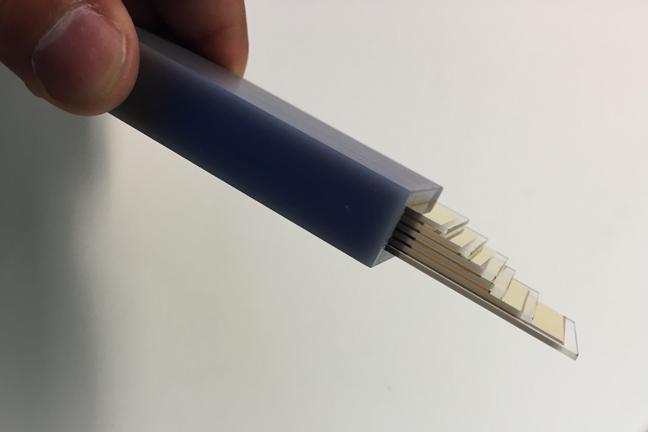
The microfluidic device used to isolate the oak wilt fungi from wood chip samples. Image: Courtesy of CFANS and Abbas Lab
Oak wilt fungus is another invasive plant pathogen that often goes unnoticed, until it’s too late. Not anymore. New technology developed by University of Minnesota College of Food, Agricultural and Natural Resource Sciences (CFANS) researcher Abdennour Abbas and his team offers a simple, affordable diagnostic test utilizing nanotechnology and gold. Abbas is an assistant professor of Bioproducts and Biosystems Engineering.
“Oak wilt is the second greatest invasive disease threat to Minnesota’s plants, second only to Dutch elm disease. The loss of elms transformed many of our urban and hardwood forests. We don’t want our oaks to be next,” says Robert Venette, Director of the Minnesota Invasive Terrestrial Plants and Pests Center (MITPPC) at the University of Minnesota.
The spread of oak wilt is sobering and serious. According to the USDA Forest Service, oak wilt fungus is present in 21 eastern states. More than 266,000 oak trees were infected by oak wilt fungus between 2007 and 2016 in Minnesota. The fungus is found spanning 25 counties including Sherburne, Anoka, Isanti, and northwestern Dakota counties.
Currently, oak wilt detection is performed by visual diagnostic (naked eye observation), which is only possible two to three weeks after infection, or with laboratory techniques that take from six hours to two weeks and cost $60 to $120 per sample. In the field, the symptoms of oak wilt can be confused with drought stress or insect damage.
The cost of infected tree removal alone is estimated to be up to $60 million at around $400 to $500 per tree. That doesn’t include the impact on related economic activities. Oak trees represent not only an important natural habitat for wildlife, but also are a natural resource for firewood, furniture, construction, and livestock feed.
The innovation by Abbas’ research lab enables oak wilt detection within 30 minutes of sampling and at a fraction of the cost: less than five dollars per sample. The technology uses the agglomeration of gold nanoparticles to generate a chemiluminescent signal that can be read by a hand-held reader, in the presence of the oak wilt fungus DNA. The team is now refining a portable system that allows early detection of the disease in the field without sending samples to the laboratory. The new technology requires only dipping wood chips obtained from infected trees into a first solution to extract the DNA, then mixed with a second solution of gold nanoparticles to allow detection using a hand-held luminometer.
“When it comes to disease detection, time is a crucial factor that decides whether lives will be saved or not. However, making a rapid detection technology is not enough. The other challenge is to make the technology affordable and easy for people to use it,” says Abbas.
“This is exactly the kind of innovation that we knew would be possible when our Center was created. MITPPC brings new talent and new solutions to the threats posed by terrestrial invasive species,” says Venette.
The work was conducted in collaboration with U.S. Forest Service Research Plant Pathologist Jennifer Juzwik and CFANS Plant Pathology Assistant Teaching Professor Brett Arenz.
This work is mainly supported by the Minnesota Environment and Natural Resource Trust Fund as recommended by the Legislative-Citizen Commission on Minnesota’s Resources, through the Minnesota Invasive Terrestrial Plants and Pests Center, and contributions from the National Science Foundation project award No 1605191, the University of Minnesota MnDRIVE Global Food Venture, and USDA National Institute of Food and Agriculture, Hatch project 1006789.
Source: University of Minnesota




